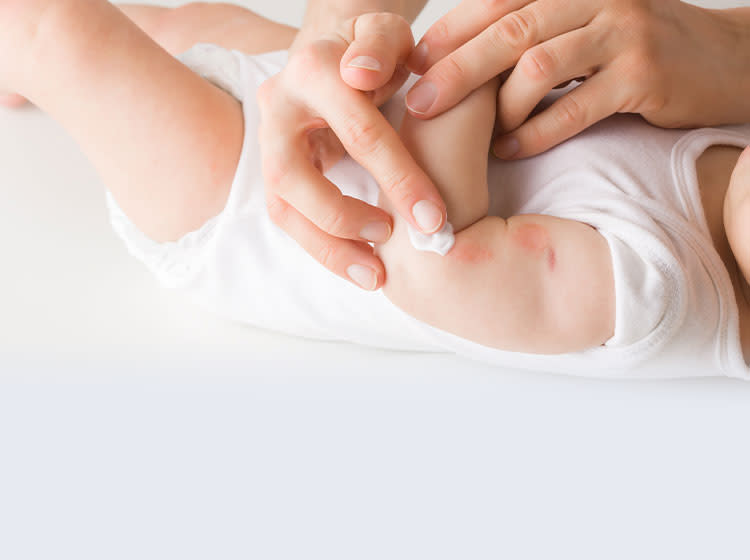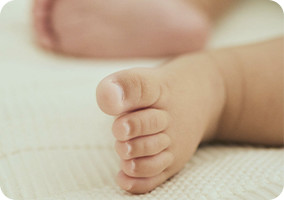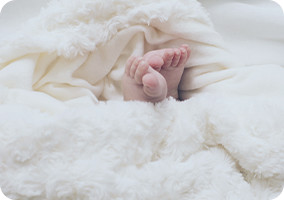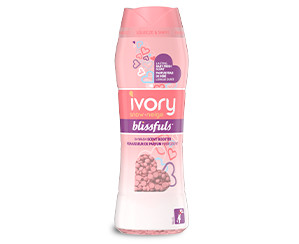What exactly is eczema?
Seeing red? Eczema in children doesn’t always look the same, but it’s a common condition that often shows up as itchy, dry, and rough skin and can be quite uncomfortable. It typically appears on your baby’s face but can also affect their arms and legs as well. It shouldn’t be confused with cradle cap, which is a less itchy issue of the scalp.² Eczema is much more severe and irritating—both for you and baby.
Eczema in infants is chronic and can come and go with frequent flare-ups while some toddler eczema goes away with time. Luckily, this condition isn’t contagious, and while there’s no sure-fire cure, a little treatment and care can lessen the symptoms and keep your baby’s skin calm.³
Signs of eczema in babies
What does eczema look like in babies? The answer is unique in every case, but some symptoms are common. It can even change in appearance due to your baby’s natural pigmentation or even their age.¹ Typically, it shows up as pink or red discoloration with patches of flaky skin and rashes. So, if you see any of the below signs, it’s best to see a pediatrician for a closer look. Here are a few things to watch out for:
Dry skin
Itchy skin
Raised and bumpy rashes
Redness or pink patches
Discoloration or hyperpigmentation
Eczema can occur anywhere on the body, but most commonly it is found on the face, scalp, feet, and limbs of your little one. While you don’t want it to escalate to infection, which can consist of blisters, sores and more, eczema can be eased at home with proper direction from your doctor.
Dry skin and Eczema. What’s the difference?
If you see a symptom, it’s easy to write it off—but eczema shouldn’t be confused with simple dry skin on your baby’s face or arms. Infant dry skin is easily cared for with moisturizer or lotion, while eczema is much more severe. Dry skin is typically due to environmental factors, while eczema can be a combination of different causes.⁴ The good news is that dry skin doesn’t always turn into eczema, but it’s best to get the opinion of a doctor to ensure your baby feels happy and healthy.
Why do babies get eczema?
Discovering what causes eczema in babies is a good step toward finding a solution. It doesn’t come down to one thing, either—what causes eczema in children and toddlers can be a combination of factors and is unique to every child. Some causes are easier to catch, while others are best managed with the help of a pediatric dermatologist. Here are some possible causes and triggers:
Irritants and allergens, such as scratchy fabrics and scented soaps. That’s why it’s important to use a hypoallergenic detergent made with children in mind. Heat and sweat due to temperature or dry air can make itching worse. Overactive immune systems that confuse healthy skin cells as foreign invaders. Genetics and differences in DNA that can affect your baby’s body in different ways.
How to treat baby eczema
So you’ve seen the signs—now how do you soothe your baby’s sensitive skin? There are some easy ways to treat baby eczema and make your baby more comfortable. With a doctor’s direction, you can try topical ointments and moisturizers that can help reduce itching and swelling.³ But one of the easiest things to do is to eliminate possible triggers altogether and avoid fragranced soaps or lotions. Your detergent can also make a big difference for successful baby eczema treatment.
There’s no need to fear fabrics and detergents as long as they’re designed with sensitive skin in mind. Ivory Snow is the #1 pediatrician- recommended baby detergent and doesn’t stop at simply getting rid of stains and spots. It’s hypoallergenic and free of added chlorine, dyes, and phosphates that could contribute to the irritation of your child’s skin.
Take a sniff for yourself—its dermatologist-tested scent is made specifically for sensitive skin so that your baby can smell fresh and feel their best. Ivory Snow detergent is considered a Safer Choice by the EPA, meaning its ingredients are safer to both your infant’s health and environment. At the end of the day, Ivory Snow is an easy way to help with infant eczema treatment. A soothing, lukewarm bath never hurts, either!
Preventing eczema in babies
Now you’ve seen some options for baby and toddler eczema treatment, how can you prevent eczema? There aren’t many guaranteed ways to stay ahead of eczema, but here are a few tips to try:
Moisturize your newborn’s skin ahead of time. Starting from birth, you can keep your baby’s skin hydrated and happy.
Eat a healthy diet while pregnant that’s rich in fruits and vegetables, fish, and vitamin D.
Taking a probiotic during pregnancy⁵
The above tips are some initial steps you can take to prevent eczema, but as always, look to guidance from your doctor or pediatric dermatologist for the best course of action. If you’re already dealing with childhood eczema, check out the above tips for treatment and try a hypoallergenic detergent like Ivory Snow.








